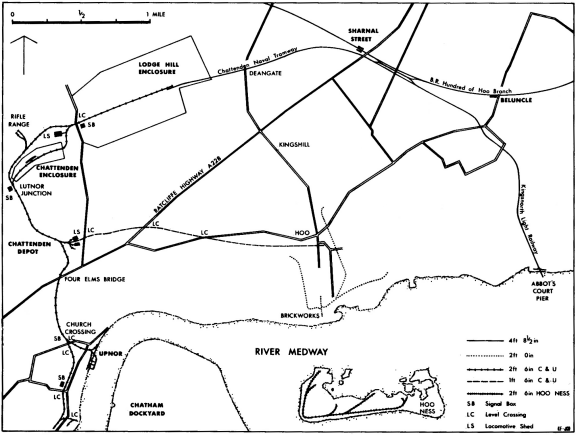
| THE INDUSTRIAL RAILWAY RECORD |
© DECEMBER 1966 |
LODGE HILL & UPNOR
RAILWAY
D. YEATMAN
The story of the Lodge Hill & Upnor Railway begins in 1873 when a Manning Wardle 1ft 6in gauge locomotive named BURGOYNE was sent to the Royal Engineers at Upnor to assist in the construction of a light railway, which was to be known as the Chattenden & Upnor Railway. Some of the line must have been laid to 4ft 8½in gauge as we hear that six Aveling & Porter engines of 2−2−0 design were also supplied. These 5−ton "Steam Sappers" had two sets of wheels, one for road work and a flanged set for use on rails.
Chattenden Barracks (just behind the Railway Depot) was then the centre of the School of Military Engineering. By 1875 work had progressed so well that there were some four miles of track from Pontoon Hard, via Tank Field and Church Crossing to the Railway Depot with a spur line going from the crossing towards Lower Upnor, as well as a one and a half mile line from Chattenden to Hoo Creek.
Some of the early locos are only names to us now, e.g. CENTAUR and HARVEY (or HARRY). but one of which we know a little was the ROYAL ENGINEER - an 0−4−0 saddle tank built in 1876 by Manning Wardle.
The magazines in the Chattenden enclosure were built between 1876 and 1878 by convict labour and the railway was, therefore, extended. The convicts were brought over daily in chains by boat from Chatham (originally they were housed in hulks on the Medway) and thence by the railway to Chattenden. Subsequently the line was straightened where it crossed Four Elms Hill by a level crossing and a bridge was built instead. In 1885 the line was extensively relaid and probably converted to 2ft 6in gauge where it was not already that gauge. (It is not known whether the Hoo line was ever relaid to 2ft 6in gauge - it is shown on the 1895 revision of the 6in Ordnance map as an "old tramway" - Hon. Eds.).
The 8th Railway Company of the Royal Engineers managed the line and used it extensively for training and for the transport of men and stores. In 1891 there were in each direction six powder and nine passenger trains, the latter conveying one hundred passengers a time. The railway was further extended about 1892 to a point just inside the west end of Lodge Hill enclosure. During 1893-1894 something like 59,000 personnel and 21,000 tons of explosives were carried, but there was very little activity from 1899 to 1901 because most of the officers and men were on active service in South Africa.
In 1891 the Admiralty took over from the Army full responsibility for the supply of armament stores to the Fleet, and in consequence acquired Upnor Depot; the railway subsequently accepted both Admiralty and Army traffic. In 1902 a new armament depot was built for the Admiralty in the Lodge Hill enclosure and in 1905 Chattenden enclosure was given over in exchange for Naval magazines in another district. About this time the narrow gauge line was extended to the east end of Lodge Hill and a transfer point made with the standard gauge line running to Sharnal Street. It was to be expected that negotiations would be opened for the Admiralty to take over full control of the rail system and this transfer was made on 1st April 1906 when the Railway School moved to Longmoor in Hampshire.
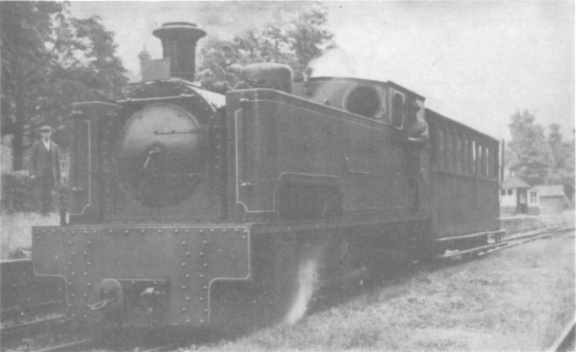
NORBURY leaving Chattenden station on a passenger train for Lodge Hill in June 1949. (G. Alliez)
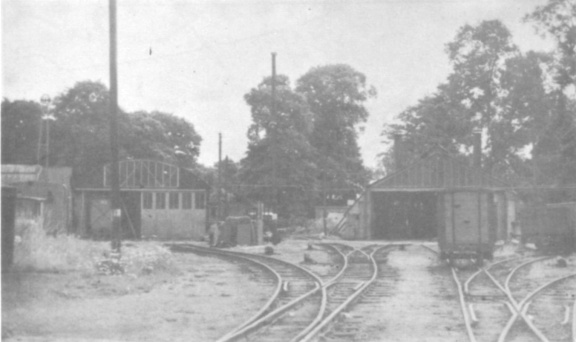
Chattenden railway depot yard in 1949.
The former line to Hoo passed
between
the carriage shed (left) and locomotive shed (right). (G. Alliez)
It is very fortunate for our story that I was able to contact "Pompey" Clackston, one of the original Admiralty loco drivers, who entered Admiralty service in 1893 and lived all his life within a mile of the railway. He retired in 1936 after driving some 300,000 miles but came back as a relief driver during the Second World War. As a boy he recalls seeing Four Elms Bridge built and can recall some of the early locomotives such as NAPIER (1881). TIPSTER (1882) and NICHOLSON (1885). Other locomotives which may have been used are the second BURGOYNE (1885) and the first PIONEER (1885), VAUBAN (1885) and GORDON (1885). CUMBERLAND (built by the Lowca Engineering Company in 1893) operated at Upnor for some years but had left the railway before 1904.
In 1904 the Army locomotives consisted of SULPHUR (1885), CARBON (1886), CHESHIRE (1890), LANCASHIRE (1891), STAFFORD (1897). BAGNALL (1897), LORD KITCHENER (1902), YORKSHIRE, the second PIONEER (1904) and ASCENSION (1904). The admiralty took over all these locomotives in 1906 except PIONEER, a 2−6−2 pannier tank built by the Yorkshire Engine Co. Ltd. It went to Longmoor in 1905 and from there to the St. Austell & Pentewan Railway. In 1917 it was offered to the Admiralty authorities for use at Chattenden but the offer was not not taken up and it was sold to the War Department at Sunbury, whence we lose track of it, PIONEER was of unusual design, with bar and plate frames, Walschaerts valve gear and equipment for oil firing.
Mr A. W. F. Burton was the first Admiralty Officer-in-Charge of the railway, which from 1906 became the Lodge Hill & Upnor Railway. He recalls that "before the railway was taken over it was worked by two companies each a hundred strong under a Captain Sewell. Each Sunday about sixty men in full uniform used to parade at Upnor Church and travel down by train. Our rolling stock for conveyance of ammunition consisted of twenty−one armoured trucks, weighing three tons each and holding about 1½ tons of ammunition. We soon got out a lighter timber-topped design weighing about 2 tons and taking 3 tons.
"A passenger coach was converted from an old ballast truck. In the winter the guard’s van and passenger truck were warmed by a red hot shot (i.e. a cannon ball - Hon. Eds.) buried in a drum full of sand. The crew of SULPHUR, which had no covered cab, wore oilskins and sou’westers when it rained and "fearnought" suits in the winter.
"The Railway Depot, where all rolling stock maintenance took place, was guarded in silent hours by two watchmen working "watch and watch", who were later trained as firelighters to raise steam on the duty locomotive. Lowe, one of the first watchmen, later became foreman. Gates were provided across the Lower Upnor road at Church Crossing Signal Box, and a barrier operated by the Police for Bosun’s Lane (which ran beside Upnor Depot wall).
"About this time roller bearings were provided in the rolling stock and this increased the tonnage of freight which could be hauled. A number of the most severe curves of the line, particularly on the approaches to Four Elms Bridge, were cleared but, of course, we could never do much about the gradient. The 1 in 26 from Upnor Depot to Church Crossing, the 1 in 30 above the crossing and the 1 in 34 outside West Gate Lodge Hill were the worst parts.
"The signal box and home and distant signals at Lodge Hill were erected about 1909 to replace and supplement the old ground level box and a gate was provided to guard the road which ran beside the Lodge Hill fence."
"Pompey" Clackston recalls that he was one of the original Admiralty drivers given a six−week training course by the Army in 1906. "Some of the engines we took over had quite an interesting career before we acquired them The STAFFORD and BAGNALL (1897) had seen service in South Africa during the Boer War whilst LORD KITCHENER (1902) was stated to have been used in Egypt with a siege train (complete with heavy gun) in the campaign against the Mad Mullah. The BAGNALL was an experimental or training locomotive for the Royal Engineers; it had a very high saddle tank, was very costly to run and was quite unsuitable for 2ft 6in gauge. The STAFFORD (later renamed EARDLEY WILMOT) was a remarkable locomotive with experimental valve gear etc., which made it extremely economical with fuel, but the valve settings were a nightmare.
"On St. Patrick‘s Day, 1907, not long after we took over the line, Colonel Brabazon, the senior officer at Lodge Hill, decided to have an official photograph taken of all seventy-eight employees outside the Main Office (just opposite the signal box in the Lodge Hill enclosure). The train drawn by LANCASHIRE stood a few yards past the group further inside the depot on an incline, whilst the driver was included in the group. Suddenly the engine started off on its own, just missing one of the Metropolitan Policemen or duty at the gate - he had his coat ripped - and gathered speed down the incline (1 in 34) until it fell off at the curve by Chattenden Enclosure. The driver came in quite a few yards behind - a poor second! Next day all the villagers turned out to see our efforts to right the engine."
Let Mr Burton continue the story. "We had no breakdown equipment except for the 5 ton screw-jack and as the accident occurred at "outmuster" on a Saturday we had difficulty in getting tackle and ropes from Chatham Dockyard. Eventually we started work on replacing LANCASHIRE on the line about 3 p.m. on Saturday and finally got her safely into the loco shed at Railway Depot at 3.30 p.m. on Sunday.
"During Saturday afternoon when about twenty men were hauling on tackle leading through a heavy block and secured to an oak tree, the strop parted and the men sat down as one!
"There was much official correspondence on the subject and the Admiralty ordered that the driver should be derated. This took place and he was transferred to Chatham Gun Wharf where, with the introduction shortly afterwards of acetylene welding, he became our number one welder on a rate of pay well above that of driver!"
The biggest white elephant on the line was the EARDLEY WILMOT, a diesel locomotive built in 1911 by a firm (McEwan, Pratt & Co. Ltd.) which went bankrupt before construction was finished. It was completed at Chatham Dockyard but after four years’ efforts it still would not run. Finally by liberal and frequent applications of petrol the engine was persuaded to haul a load of some fifty tons up from Upnor to Chattenden. Shortly afterwards approval was given to scrap the STAFFORD, but not the EARDLEY WILMOT, so the nameplates were hurriedly switched and the white elephant was buried at last!
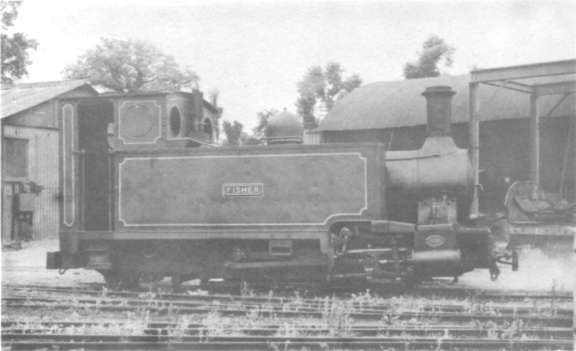
Scotland‘s contribution to the line, FISHER, at Chattenden in 1949. (G. Alliez)
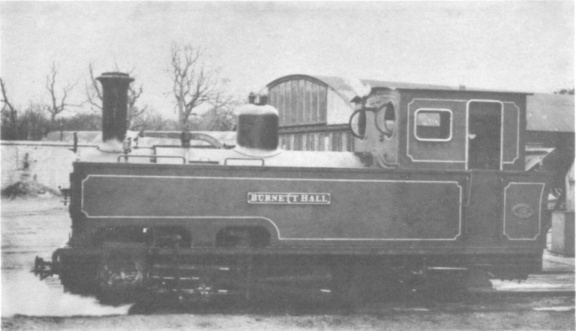
BURNETT HALL, seen here at Chattenden in 1949, was the last
steam
locomotive to leave the railway. (F. Jones)
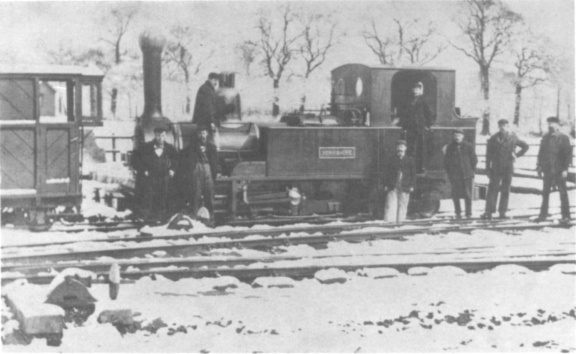
Shunting in the snow: YORKSHIRE and brake van. (Author‘s collection)
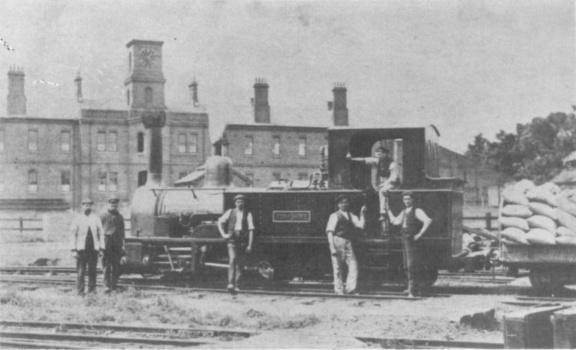
YORKSHIRE poses under the barracks clock at Chattenden. (Author‘s collection)
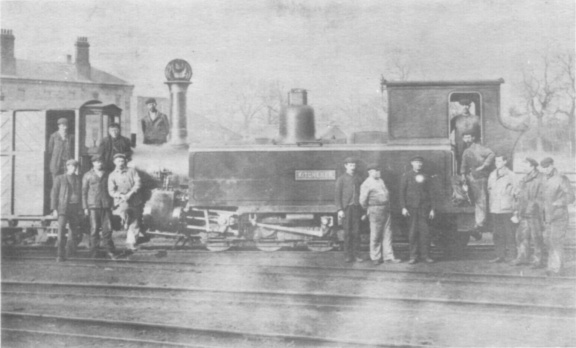
KITCHENER with a different brake van to the one shown opposite. (Author‘s collection)
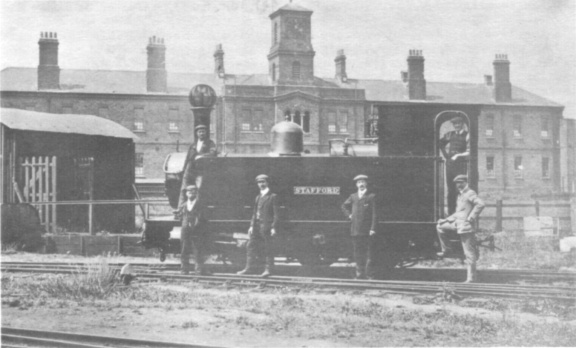
STAFFORD. (Author‘s collection) The four photographs featured
here [above] are believed to have been taken in 1907 or thereabouts.
At the start of the First World War two new locomotives were ordered by the Admiralty and delivered in 1915. These were the FISHER (Dick Kerr) and the CHEVALLIER (Manning Wardle), both rated at 70hp. The latter is now the only survivor of the Upnor steam locomotives and may still be seen at the Bowater paper mills at Sittingbourne.
In 1931 the rolling stock consisted of KITCHENER, CHEVALLIER, FISHER and EARDLEY WILMOT, together with 91 powder trucks (of 2 to 3 tons capacity each), 16 box trucks for ammunition (10 tons), 17 assorted trucks for ballast and other special uses, an officers‘ coach, 7 workmen‘s coaches, 3 brake vans, and a breakdown van. These were further augmented by six electric tractors capable of hauling 2 to 6 ton loads, and eight electric trucks for loads of up to 36cwt.
It was the practice from the early days to transport workmen by train from the Railway Depot (the nearest point to the main road) to the Chattenden and Lodge Hill enclosures. One Sammy Lake, nicknamed Sammy ‘Late’, was always the last to catch the train. One morning the guard and engine driver decided to cure him. As he approached, the train started off and kept just ahead of him. Finally Sammy gave up the chase and strode off back home to Strood, some three miles away. As he entered the backyard his prize cockerel crowed at him, whereat Sammy, so incensed, wrang its neck saying:- "You ----- bird, I’ll teach you to crow at me."
The last two steamers were the BURNETT HALL (75hp) and the NORBURY (80hp), delivered in 1933 and 1934 respectively. These bore the brunt of wartime traffic until some twenty years later they were replaced by three large diesels. About 1940, NORBURY was carefully dismantled and sent to the new depot at Trecwm where it was reassembled and put on the line. Unfortunately it fouled all the tumblers (i.e. point levers) and so was smartly returned to Lodge Hill.
The line was in constant use throughout the Second World War when the depots were worked on a three shift system. The alternative method of transport, by 3-, 5- or 10−ton lorries on narrow roads some two miles longer, was not popular in times of blackout and petrol shortage. In the post war period there was a scheduled service of nine trains daily each way, with additional ones according to work requirements.
Three 100hp diesels were purchased between 1947 and 1955 - a Hunslet in 1947, a Drewry in 1949 and a Hibberd (‘Planet’) in 1954. Of these the Drewry was transferred to an armament depot in the Plymouth area in 1960 and the other two were put up for sale in 1961.
Before disposal in 1961 the associated rolling stock consisted of four passenger coaches having 40 seats, a 22−seat composite brake van, a goods brake van which had seats for 8 passengers, a breakdown van and more than 150 assorted 3- to 5−ton powder trucks, 10−ton box trucks, 10−ton barsi trucks, 7−ton open trucks, etc. All the passenger carrying vehicles have since been transferred to the Welshpool and Llanfair Light Railway.
It was indeed a sad day on 29th May 1961 when the last scheduled train ran from Upnor to Lodge Hill. The line was later taken over by the War Department and in December 1965 the track was lifted.
* * *
EDITORS’ NOTE: We are indebted to Mr S. A. Leleux for persuading Mr Yeatman to submit the above article for publication. The author mentions certain locomotives which do not feature in the Club’s records and we have therefore compiled the following locomotive lists. Identification of the early locos connected with the railway is extremely difficult, as they may have arrived at Chattenden via Woolwich Arsenal, Chatham Dockyard or some other main depot. Many are remembered by name only and it is not always clear to which gauge these names refer. The lists are based on the Author’s notes, a list published in the April 1960 issue of "Naval Armament Journal", the Club’s records and information kindly supplied by Messrs. Greenwood & Batley Ltd. and Mr J. P. Mullett. Needless to say, readers’ comments will be most welcome.
ABBREVIATIONS USED IN THE LOCOMOTIVE LISTS
| 4w | - Locomotive having four—wheel drive but no coupling rods | ||
| D | - Diesel locomotive | SC | - Single Cylinder |
| f | - Formerly | s/s | - scrapped or sold |
| OC | - Outside cylinders | Scr | - Scrapped |
| PT | - Pannier Tank | T | - Side Tank |
| ST | - Saddle Tank | TG | - Tank loco with geared drive |
STANDARD (4f t 8½in) GAUGE LOCOMOTIVES
Certain of these locomotives worked at Chattenden Barracks and latterly on the line from Lodge Hill to Sharnal Street (the "Chattenden Naval Tramway") which was in existence by 1905. (The South Eastern Railway reached Sharnal Street from Hoo Junction in 1882.)
| 2-2-0TG | SC | Aveling.& Porter | 129 | 1865 | † | s/s | |
| 2-2-0TG | SC | Aveling.& Porter | 182 | 1866 | † | s/s | |
| 2-2-0TG | SC | Aveling.& Porter | 218 | 1866 | † | s/s | |
| 2-2-0TG | SC | Aveling.& Porter | 718 | 1871 | † | s/s | |
| 2-2-0TG | SC | Aveling.& Porter | 719 | 1871 | † | s/s | |
| 2-2-0TG | SC | Aveling.& Porter | 1023 | 1874 | † | s/s | |
|
STEAM SAPPER No.3 |
2-2-0TG |
SC |
Aveling.& Porter |
822 |
1872 |
|
s/s |
| STEAM SAPPER No.4 | 2-2-0TG | SC | Aveling.& Porter | 829 | 1872 | s/s | |
| STEAM SAPPER No.5 | 2-2-0TG | SC | Aveling.& Porter | 830 | 1872 | New | s/s |
| STEAM SAPPER No.6 | 2-2-0TG | SC | Aveling.& Porter | 831 | 1872 | s/s | |
| STEAM SAPPER No.7 | 2-2-0TG | SC | Aveling.& Porter | 832 | 1872 | s/s | |
| STEAM SAPPER No.8 | 2-2-0TG | SC | Aveling.& Porter | 939 | 1873 | s/s | |
|
ROYAL ENGINEER |
0-4-0ST |
OC |
Manning Wardle |
602 |
1876 |
New |
(1) |
| VAUBAN | 0-4-0ST | OC | Manning Wardle | 937 | 1885 | (a) | (2) |
| BURGOYNE | 0-6-0ST | OC | Manning Wardle | 949 | 1885 | (a) | s/s by 1904 |
| PIONEER |
0-4-0ST |
OC |
Manning Wardle |
962 |
1885 | (a) | s/s by 1904 |
| HARVEY (or HARRY) | s/s | ||||||
| NAPIER | * † | 1881 | s/s by 1904 | ||||
| TIPSTER | * | 1882 | s/s by 1904 | ||||
| NICHOLSON | * † | 1885 | s/s by 1904 | ||||
| GORDON | * † | 1885 | s/s by 1904 | ||||
| LUCIFER | * | (3) | |||||
|
V3 YARD No.91 |
0-4-0D |
|
Hunslet |
3133 |
1944 |
New |
(4) |
| YARD No.43 | 4wD | Ruston & Hornsby | 221639 | 1943 | (b) | (5) |
* Gauge uncertain (may have been 2ft 6in or 1ft 6in).
† See notes below
NOTES. The author is certain that there were six, and thinks there could possibly have been nine, ‘Steam Sappers’ in use on the railway. One such machine, STEAM SAPPER No.5, is featured elsewhere in this issue, and we can be reasonably certain that this locomotive did work on rails at Chattenden. Messrs. Aveling & Barford state, however: "We were not under the impression that the Steam Sapper was intended as a road-rail conversion machine. It was specially designed as a traction engine for Military Service. They were light machines specially constructed so that the weight did not exceed that of the heaviest siege gun and so ensured that pontoon bridges were not overloaded." The Club records show that there were six Aveling and Porter locomotives in the area at this time, although they are thought to have been at Chatham Dockyard. These, and the six Steam Sappers, are listed above but we have no evidence that any (other than STEAM SAPPER No.5) were used here.
Regarding the locomotives marked *† in the list the War Department, Royal Artillery Gunnery Establishment at Lydd, Kent, obtained a new standard gauge locomotive in 1906 (Hunslet 882) which was named NAPIER. In the same year 0−6−0ST IC Manning Wardle 948 of 1885 was disposed of, presumably having been replaced by the Hunslet. There is evidence of many locomotives at WD depots being given the names of the locomotives they replaced, and there is therefore a possibility that MW 948 was also named NAPIER. Manning Wardle records show that 948 was built for the Lucas & Aird Suakin & Berber Railway contract, and confirm that the loco was later at Lydd. It is possible that the loco was in fact at Chattenden prior to going to Lydd, though we have no factual evidence to support this.
Another loco at Lydd was 0−4−2T OC John Fowler 10978 of 1907, named NICHOLSON. It has not yet been confirmed that it was delivered new to Lydd in 1907, but this seems likely as Lydd disposed of 0−6−0ST IC Manning Wardle 968 of 1885 in 1907. As reasoned above, there is therefore a chance that MW 968 wag named NICHOLSON. Again, Manning Wardle records state that 968 was built for Suakin & Berber, and later passed to the "Secretary of State for War" (i.e. the War Department). Therefore, the NICHOLSON at Chattenden could have been Manning Wardle 968, though again the evidence is circumstantial.
Very little is known about GORDON, but if this were also a standard gauge Manning Wardle obtained from Lucas & Aird, it could be either 941, 967 or 969, all built in 1885 for the Suakin & Berber contract, and all noted in Manning Wardle records as having been owned by the Secretary of State for War.
* * * * * *
Details of locomotives used on the Lodge Hill to Sharnal Street line from about 1904 to 1944 are unknown. However, in later years this line made an end−on connection at Sharnal Street with the Kingsnorth Light Railway - a line operated by Holm & Co. Ltd., who seem to have obtained their first standard gauge locomotive (0−4−0ST OC Kerr Stuart 4227 of 1929) in 1929. The KLR ran from Sharnal Street to a pier on the Medway about 1½ miles east of Hoo. It is understood that this line and premises were disused when taken over by Holm & Co. Ltd., but had previously been laid out as an Admiralty Royal Naval Airship Station. This Station operated during the First World War and had its own locomotive (0−4−0ST OC Andrew Barclay 1398 of 1915). This locomotive may have worked through to Lodge Hill during the period (1915 to 1919) it was at the Station, and so might the KLR locomotives until the KLR closed in 1940. We know that the KLR steam locomotive went away to Woolwich Arsenal, but of the two KLR Hardy petrol locomotives (built in 1930 and 1936) we have lost all trace. It is interesting to speculate where they might have gone.
1ft 6in GAUGE LOCOMOTIVES
These locomotives were used on the original Chattenden & Upnor line. Construction commenced in 1873 and conversion to 2ft 6in gauge was in hand by 1885.
| BURGOYNE | 0-4-0ST | OC | Manning Wardle | 448 | 1873 | New | s/s | |
| CENTAUR | * | s/s | ||||||
| LORD RAGLAN | + | 0-4-0ST | OC | Manning Wardle | 353 | 1871 | ||
| TRAFALGAR | + | 0-4-0ST | OC | Manning Wardle | 386 | 1871 | ||
| BUSY BEE | + | 0-4-0ST | OC | Manning Wardle | 424 | 1872 | ||
| FIDGET | + | 0-4-0ST | OC | Manning Wardle | 506 | 1874 |
* Gauge uncertain (may have been 4ft 8½in).
+ These locomotives were recorded by Manning Wardle as at "Admiralty, Chatham Dockyard". It is feasible (but we have no evidence) that they may have assisted with construction work on the Chattenden & Upnor Railway.
2ft 6in GAUGE LOCOMOTIVES
(i) steam & diesel.
These locomotives worked on the Lodge Hill & Upnor Railway (originally laid to 1ft 6in gauge) excepting those marked * which were used for shunting in the depots.
| ** |
Stated to have been built in 1904, but this is not correct as spares were ordered for it from the Yorkshire Engine Company as early as January 1897. |
|
(a) |
ex War Department, Crewe. |
| (b) | ex War Department, South Africa, c1901. |
| (c) | ex War Department, Egypt. |
|
(1) |
to M. Lynch & Son Ltd., Strood, for scrap, 1932 (or by 1931 per other source). |
| (2) | to M. Lynch & Son Ltd., Strood, for scrap, by May 1931. |
| (3) | to M. Lynch & Son Ltd., Strood, for scrap, April 1941. |
| (4) | to Chatham Dockyard for scrap 1948; scrapped 1954. |
| (5) | to War Department, Woolmer Instructional Military Railway, 1905. |
| (6) | to Admiralty, Hoo Ness, by 1928. |
| (7) | to Bowater Lloyds Ltd., Sittingbourne, via T.W.Ward Ltd., Silvertown, 1950. |
| (8) | to Bailey & Noyce, Itchenor, Surrey, for scrap, May 1956. |
| (9) | to Admiralty, Trecwm, Pembroke, c1940; returned c1940; scrapped on site by G. Cohen Sons & Co. Ltd., November 1955. |
| (10) | to Welshpool & Llanfair Railway, February 1962. |
| (11) | to Admiralty, Ernsettle, Devon, October 1960. |
| (12) | for sale 1961 (still here May 1961). |
| (13) | to Chatham Dockyard, for storage, 1960. |
| (14) | to Admiralty, Ernsettle, Devon, November 1960. |
(ii) battery electric.
These machines, all having four wheels, were of two distinct types.
| (a) Locomotives |
- fitted with cabs and suitable for shunting within the depots or for hauling trains on the main line. |
| (b) Trolleys |
- Cabless vehicles of limited power, being motorised wagons rather than haulage locomotives, and used only within the depots. |
(a) locomotives.
Six were in use by 1931, the first having been introduced in 1928. An old photograph in Mr Leleux’s collection shows that, although of similar overall dimensions to the latter-day machines, these early locomotives were of a more ‘rectangular’ construction. The central cab was fitted with a large square cornered window fore and aft, and the engine covers had horizontal tops. The channel section steel frames had angle-ended tramway type skirts suspended beneath them, hiding the wheels. A rectangular works plate and twin headlamps were fitted to the ends of the engine covers. The six machines listed below, all of which were in existence when the line closed, differed from those above in having rounded corners to the cab windows, sloping tops to the engine covers, deep plate frames and only one headlamp. They were flameproof machines weighing 8 tons and having a normal drawbar pull of 900lbs at 6mph. There is no reason to believe that the twelve locomotives mentioned were the only such machines on the system.
| 43 | Greenwood & Batley | 1581 | 1938 | New |
| 44 | Greenwood & Batley | 1618 | 1939 | New |
| 48 | Greenwood & Batley | 1947 | 1944 | New |
| 88 | Greenwood & Batley | 1983 | 1945 | New |
| 89 | Greenwood & Batley | 1984 | 1945 | New |
| 90 | Greenwood & Batley | 1985 | 1945 | New |
(b) trolleys.
Certain, but by no means all, of the running numbers quoted below were pre−fixed ‘YARD NO’.
G & B nos. 3277 to 3280 and 3537 to 3544, known by the makers as "rail trucks", had a capacity of 3−4 tons and were fitted with platforms 8ft long by 4ft wide.
| 28 | Greenwood & Batley | s/s by 1957 | ||||||
| 50 | -"- | 1918* | New | s/s by 1957 | ||||
| 51 | -"- | 1918* | New | s/s by 1957 | ||||
| 52 | -"- | 1918* | New | s/s by 1957 | ||||
| 53 | -"- | 1918* | New | s/s by 1957 | ||||
| 54 | -"- | 1918* | New | s/s by 1957 | ||||
| 84 | -"- | 3277 | New | (1) | ||||
| 85 | -"- | 3278 | New | (1) | ||||
| 86 | -"- | 3279 | New | (1) | ||||
| 87 | -"- | 3280 | New | (1) | ||||
| 99 | 4512 | 2 | -"- | 3540 | 1946 | New | (2) | |
| 100 | 4513 | 7 | -"- | 3539 | 1946 | New | (2) | |
| 101 | 4514 | -"- | 3538 | 1946 | New | |||
| 102 | 4515 | -"- | 3537 | 1946 | New | |||
| 103 | 4516 | 11 | -"- | 3541 | 1946 | New | (3) | |
| 104 | 4517 | 12 | -"- | 3542 | 1946 | New | (3) | |
| 105 | 4518 | -"- | 3543 | 1946 | New | (5) | ||
| 106 | 4519 | -"- | 3544 | 1946 | New | (4) | ||
| 108 | Wingrove & Rogers | s/s | ||||||
| 110 | -"- | s/s | ||||||
| 111 | -"- | |||||||
| 112 | -"- | |||||||
| 113 | -"- | |||||||
| 114 | -"- | |||||||
| 115 | -"- | |||||||
| 116 | Lodge Hill Workshops | 1932 | New | |||||
| 119 | Greenwood & Batley | |||||||
| 121 | -"- | |||||||
| 122 | -"- | |||||||
| 125 | -"- | 3586 | 1948 | (a) | ||||
| 281 | -"- | |||||||
| 283 | Lodge Hill Workshops | |||||||
| 285 | Greenwood & Batley | |||||||
| 287 | Greenwood & Batley |
* or 1919.
| (a) |
ex Ferranti Ltd. |
| (1) | to Speedwell Electrics Ltd., Nottingham; resold to John Lysaght‘s Scunthorpe, Works Ltd., Nettleton Top Ironstone Mines, Lincs., /61. |
| (2) | to Admiralty, Crombie, June 1961. |
| (3) | to Admiralty, Ernsettle, September 1961. |
| (4) | to Admiralty, Trecwm, November 1960. |
| (5) | to Chatham Dockyard for storage by May 1961. |
NOTE. Details are required of the final disposal of locomotives and trolleys where not shown above.
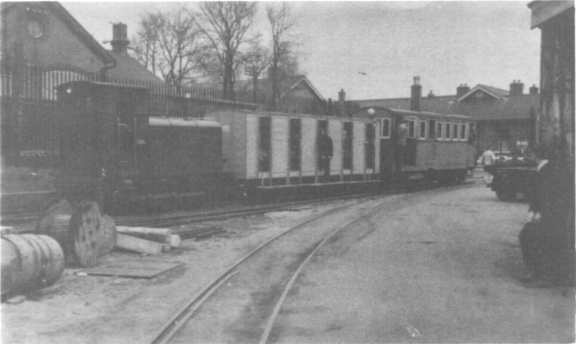
Birmingham Locomotive Club special train at Lodge Hill with Drewry locomotive No.85. (F. Jux)